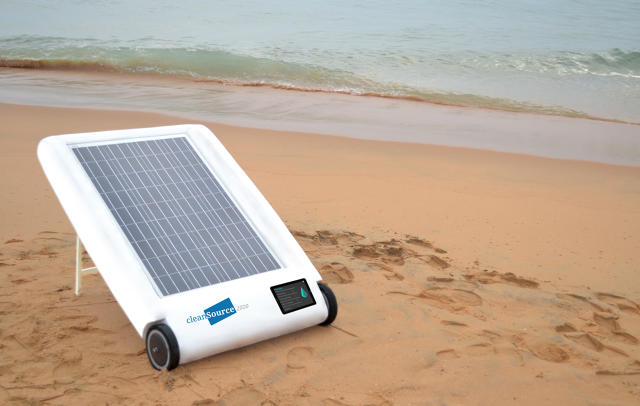Polluted or salty water becomes drinking water for a small family.
Turning saltwater into clean drinking water is usually an expensive and energy-intensive process—a new desalination plant under construction in San Diego has a price tag of $1 billion, and smaller devices can cost as much as $30,000. But a new solar-powered device could make the process affordable for the millions of people around the world who don't have running water.
Using nothing but sunlight, the Desolenator turns polluted or salty water into enough drinking water for a small family. Water heats up on the solar panel until it's boiling, and then the device uses the electricity from the solar panel to boil it more. The vapor is pure and safe to drink, while salt and heavy metals like arsenic are filtered out.

"Other devices produce more water, but they are significantly more expensive, and they require quite a bit of maintenance and consumables," says Desolenator's CEO William Janssen. "On the other side you have the solar still, the traditional solution—but that unit only produces half a gallon of water per day. Our solution can produce 3 to 4 gallons a day, enough for drinking and cooking."
It's designed for the hundreds of millions of people around the world who lack easy access to drinking water but happen to live near polluted rivers, lakes, or coastlines.
"If you look around the equatorial belt of the world, there are many countries that are very densely populated where water resources are very stressed," says Janssen. "It will get worse—by 2025, close to 3 billion people will deal with water scarcity daily. We want to give them something that's an affordable, family-sized device."
Though it may be cheaper than anything similar, it's still not exactly a low-budget item for families who might be struggling to get by on less than a couple of dollars a day. The current price is $450. But the company is working to bring the cost down, and plans to work with microfinance and leasing plans to make it attainable. It also hopes to work with nonprofits and governments for distribution.

It might not be a solution for drought-stricken cities in places like the American West, where investing in larger-scale infrastructure is probably cheaper in the long run. But it could possibly serve as a stand-in for that infrastructure in the quickly-growing cities around the world that don't have cash on hand to build a billion dollar plant—or for more remote communities, where permanent infrastructure may never come.
Desolenator is currently raising money on Indiegogo to test a new version of their prototype in a fishing village in southern India, where locals currently pay for expensive deliveries from a water truck that only shows up infrequently.
"Once we have completed the successful consumer use test, then we'll be able to go to NGOs and say this is a proven technology in field use," says Janssen. "Then we can use their distribution channels to bring it to the millions of people in places like Somalia and the Philippines to provide clean drinking water."
[Photos: via Desolenator]

Adele Peters is a writer who focuses on sustainability and design and lives in Oakland, California. She's worked with GOOD, BioLite, and the Sustainable Products and Solutions program at UC Berkeley
No comments:
Post a Comment